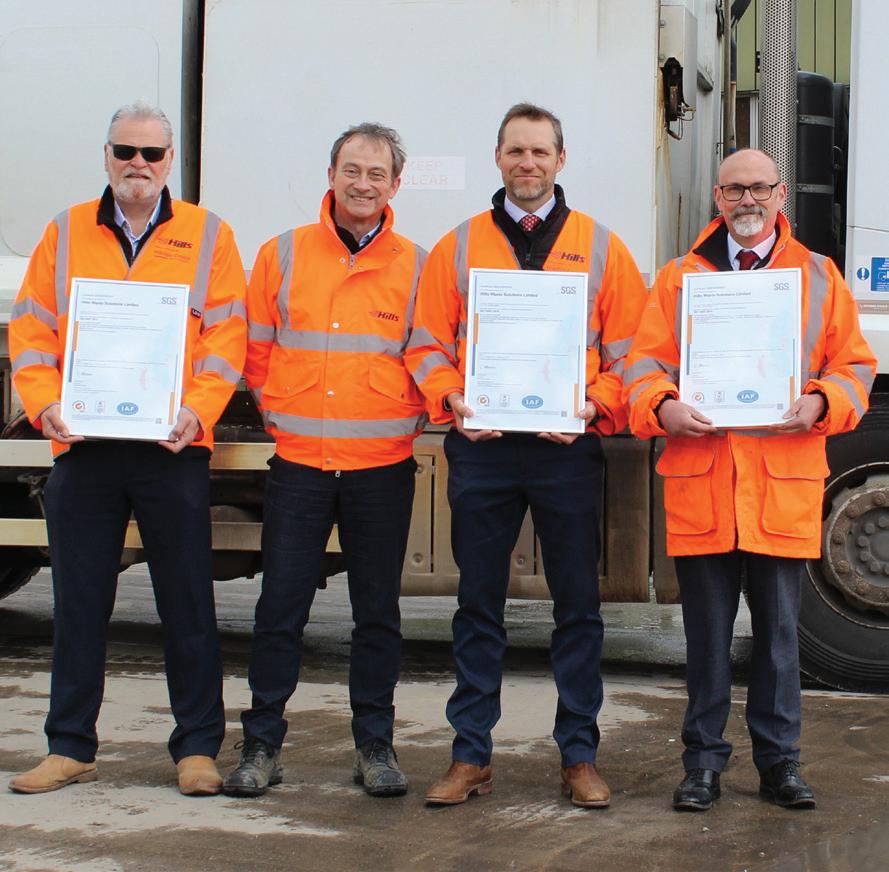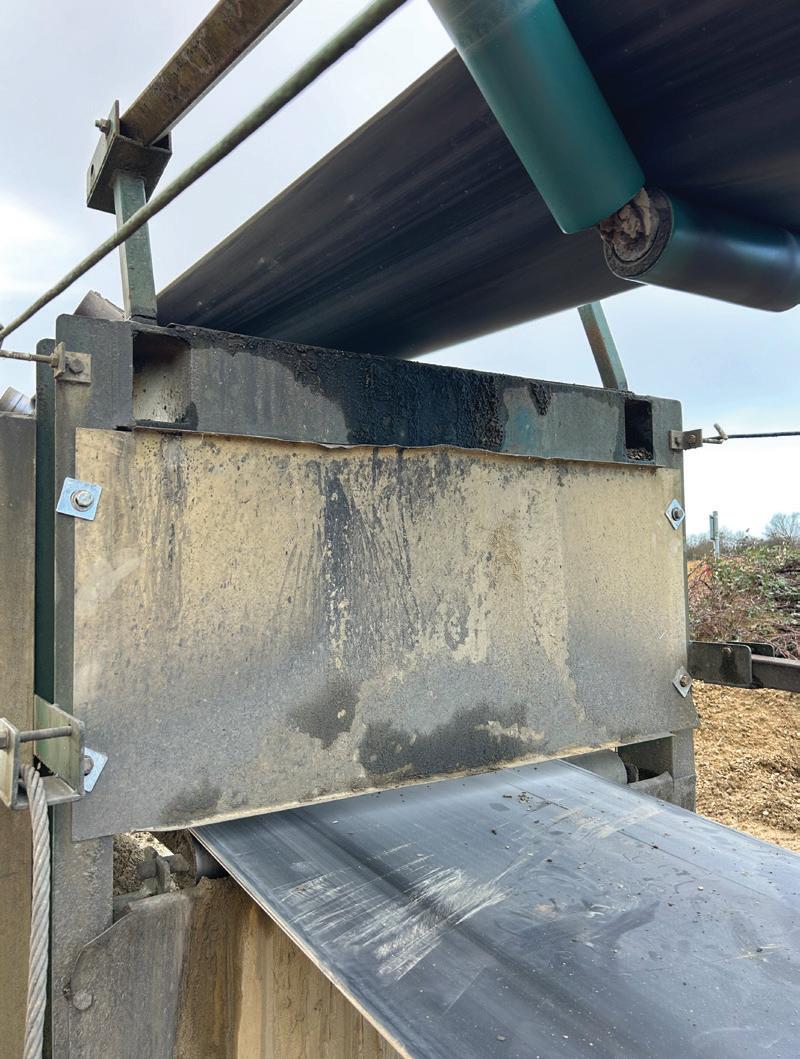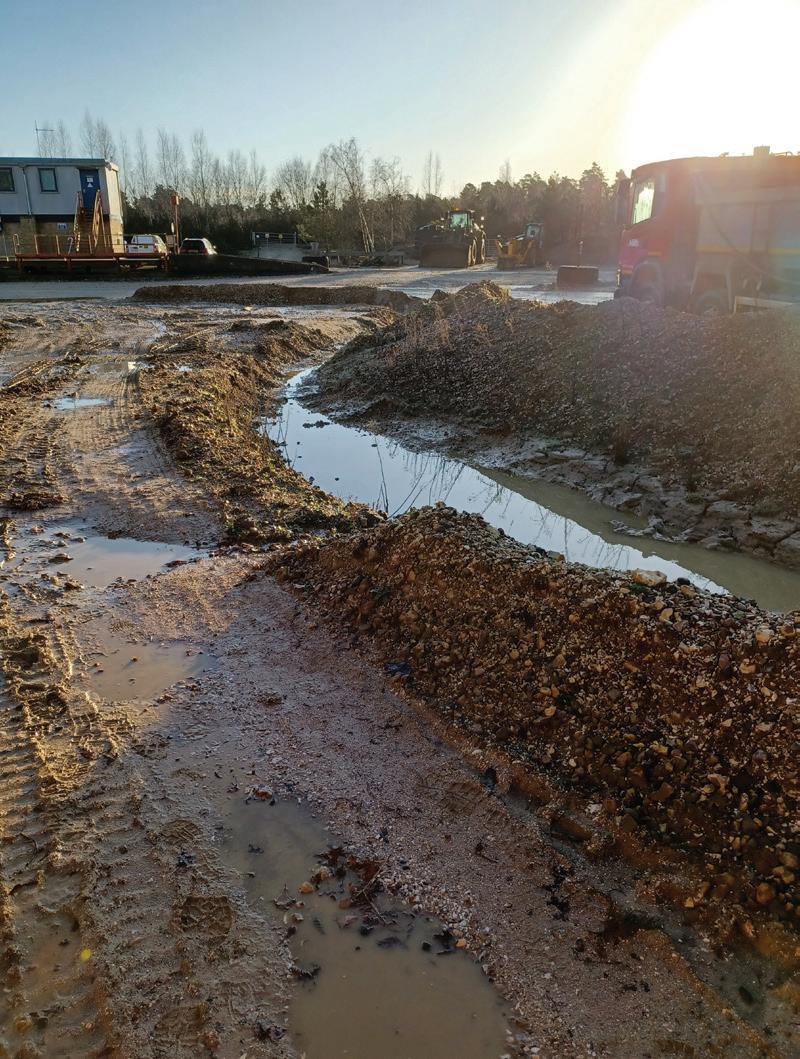











Health and Safety has become even more embedded into Hills’ DNA with this year’s launch of EcoOnline and site-specific Near Miss QR codes.






There is a comprehensive guide to reporting near misses via EcoOnline on pages 14 and 15, and I would encourage all employees to read this and use the new platform whenever relevant to do so.




As this issue of Safer For All reminds us, employees and contractors should not feel in any way inhibited to report near misses or unsafe acts no matter how small they may appear to be. Each near miss reported could prevent a serious incident or injury.
Mike Hill, Chief Executive



Waste Solutions has been successful in the recertification of its three major international standards covering the environment, health and safety, and quality assurance –ISO 14001 (environmental management systems), ISO 45001 (occupational health and safety management systems) and ISO 9001 (quality management systems).
Impressively 14001 has been held since 2010, and 45001 (formerly OHSAS 18001) and 9001 since 2011. Significantly, recertification now covers Municipal Collections.



Mia Jones, Health and Safety Manager – Hills Quarry Products
We are keen to applaud team successes, and it’s worth celebrating that since the launch of the near miss QR code reporting mechanism in January, our people have reported more near misses during the first quarter of 2025 than during the whole of 2024. This achievement highlights that our focus on health and safety is improving, all our eyes are open, and we are looking out for each other, our contractors, our customers, and visitors. In this issue of Safer For All we share some images of our near miss reports, and the corrective and preventative measures taken to avoid future incidents. Thank you and keep on reporting.


Since January, the Company has been focussing on standardising key aspects of the health and safety systems across The Hills Group. We have concentrated on expanding into the wider Group a number of key systems which were initially developed, trialled and rolled out in Waste Solutions as part of the EcoOnline software implementation programme. This collaborative approach will enable us to more efficiently manage, monitor, measure and continually improve what we do across the Group. Thank you to everyone involved for their energy and positive commitment to making this happen.
Tinson, Divisional Managing
Health and safety is about protecting people: ourselves, our teams, and reassuring those we go home to at the end of the day. With the implementation of QR code posters and stickers across our sites, we are doubling down on our efforts to get Homes’ contractors involved with reporting near misses and unsafe acts and to change the culture where reporting near misses is seen as “telling tales” – it isn’t, it’s taking action to prevent serious incidents. Health and safety is non-negotiable. It’s not just a rule for site; it should be a mindset we take with us at all times.

No matter how small you think an issue is, if you see it you should, if safe to do so, sort it immediately and you should always report it. See it, sort it, report it…
The following examples are unsafe conditions and unsafe acts that have been seen, sorted and reported. By maintaining this approach to near miss reporting you, are making Hills Safer For All.

Incident Unsafe situation:
An emergency stop (e-stop) on a conveyor was obstructed and inaccessible with a bag hanging off the button.

Action taken:
Obstructing items were removed, and shift teams were reminded that clear access to all emergency stops must be maintained at all times.
A driver was observed climbing onto a bin lift to clean the rear-view camera.
Action taken:
The driver was reminded to use the extending camera cleaning pole and instructed never to climb onto the bin lift, reinforcing safe work practices.

A section of old walkway had lifted, creating a significant trip hazard.
Action taken:
The walkway was replaced with a more robust, high-visibility structure and is now included in the site’s weekly inspection checklist to ensure ongoing safety.


Poor housekeeping led to the accumulation of waste material around the base of a key structure.
Action taken:
The area was thoroughly cleaned, and all waste material was removed to prevent further hazards.

A loader was observed not wearing a seatbelt during operations.
Action taken:









































All crews were reminded of the mandatory seatbelt policy and the importance of adhering to safety protocols.





































A contractor’s cherry picker was left unattended in the car park with the key in the ignition while awaiting collection.
Action taken:
The key was removed to prevent any risk of unauthorised use, reinforcing best practice around equipment security and site safety.
Aluminium poles were found stored on the ground, protruding into a pedestrian walkway and creating a slip, trip, and fall hazard.
Action taken:
The poles were relocated immediately, and teams were reminded of the critical importance of keeping walkways clear at all times.

A protective guard had snapped off the head of a conveyor, posing a potential safety risk.
Action taken:
Production was halted, the plant was isolated, and the damaged guard was promptly replaced to restore safe operating conditions.


A stair handrail was discovered to be detached from its structural support.
Action taken:
The handrail was securely reattached, ensuring safe use of the stairs.


An inadequate bund presented a fall risk for both personnel and vehicles.
Action taken:
The bund was extended to the end of the ditch, significantly improving edge protection and reducing fall risk.

A contractor working at one of our sites reported that a reversing mirror was clipped and damaged.
Action taken:







Arrangements were made to fix the mirror and the site team and contractors were made aware and reminded of the importance of reporting all near misses no matter how small.






All Hills’ employees can now access FREE counselling via our Bupa Employee Assistance Programme (EAP).
Among other benefits the EAP entitles you to six telephone and six face-to-face counselling sessions to discuss whatever is on your mind – whether it’s stress, bereavement, financial worries, anxiety and depression or family issues.
For a confidential chat, please call 0800 269 616
When calling, you will only be asked for your date of birth, gender and home postcode. You can start an online CBT assessment at: bupa.com/cbt PIN: BuPaHM Useful self-help tools can be found at: bupa.co.uk/eaponline
• 24/7 mental wellbeing helpline
• initial clinical assessment by phone
• counselling by phone
• counselling by video call or face-to-face
• legal helpline
• financial helpline
• child and dependant care helpline

• manager helpline
• 24/7 Anytime Healthline
• online cognitive behavioural therapy provided by SilverCloud Health supported by a Bupa therapist
• online mental wellbeing programmes provided by SilverCloud Health
• EAP online for self-help information and advice.
Stay cool




Keep hydrated


Whatever the British weather throws at you, it’s important to stay safe when working in hot conditions. Keeping cool and taking regular breaks can help prevent heat stress and other seasonal related hazards. Read our tips below on how best to tackle higher temperatures.


Remove layers of clothing from under your PPE to reduce sweating and overheating.



Regularly drink plenty of hydrating liquids (preferably water) to prevent dehydration. It’s best to avoid caffeinated and carbonated drinks where possible. Slow down

Take regular breaks to cool down in hot conditions. In extreme conditions such as heatwaves remember to slow down and not rush around.
Seek shade




Wherever possible don’t work in direct sunlight. If you are unable to avoid this, make sure you seek shade during your breaks and lunchtime.
Stay protected



If it’s sunny outside, ensure you cover up exposed skin with a high-factor sunscreen and keep it topped up throughout the day.











































With changeable conditions, the heat can really creep up on you. As thermometers rise and the sunshine returns once again, unfortunately so does the risk of heat stress.






Heat stress occurs when the body is unable to control its internal temperature. Seasonal changes to humidity levels and outside air temperature and working in direct sunlight can all increase your likelihood of suffering from it.


Early detection and prompt action may prevent heat stress from escalating into more severe conditions such as heat exhaustion or heat stroke, which can be fatal. That’s why it’s important to know the signs, especially if you are working outdoors or in a hot environment. Signs of heat exhaustion
Signs of heat stroke
If you see an unsafe act or an unsafe condition, sort it (if it is safe to do so), then use your mobile phone to report it as a near miss.





Scan a QR code on the site where the near miss occurred to be taken straight to step 2 or scan the above generic QR code.
If a QR code isn’t available, you can also click the Near Miss icon on your company issued mobile phone or PC desktop, as shown above:
Clicking the Near Miss icon will take you to our Near Miss web page, (see above) where you can choose the relevant site (listed alphabetically by division).
You will then be taken to the EcoOnline platform. The site details are pre-populated, depending on which site QR code you have scanned
You have the option to upload a photo of the near miss (unsafe act or unsafe condition).

The date of the incident and date it was reported are pre-populated, depending on the date the QR code was scanned.
Add time details for these sections from the grey drop-down menus.
The ‘Historical Data Reference’ is automatically generated by the system.
Add how many hours and minutes into your shift the near miss incident occurred. You can add the location of the near miss incident by clicking on the small map icon. You can also add the longitude and latitude, should you know it.

The next fields allow you to add a specific location and details of the task or process being done at the time of the incident.
If you click within ‘Kind of (Potential) Incident’ it will bring up a drop-down menu of 16 incident types that the near miss had the potential to create.
‘Description of the incident’ allows you to type a fuller description of what happened.
There is also an open text field, which allows you to describe the ‘immediate actions taken’.

The final details to add are the name of the person reporting the near miss (this may be an employee if you are recording the near miss on their behalf) and your email address.
You can then submit the near miss via EcoOnline to help make Hills…

Answer the simple quiz questions below then scan or photograph this page and email to comms@hills-group.co.uk. Alternatively, cut off this page and send to the Communications and Marketing department via internal mail at County Park, Swindon. Competition deadline: 31 August 2025.
Name: Location:
1. Name two signs of heat stress
2. What should you do if a colleague shows signs of heat stroke? (Fill in the blank.)
Seek immediate __________________ attention
3. How much does BUPA counselling cost employees? (Tick one.)
£50 a session
£20 a session
It’s free of charge
4. Why should we all report near misses and unsafe acts? (Fill in the blank.)
To make Hills __________________ for all
You could win one of three £50 Tesco vouchers! £50
5. Which three ISO certifications has Hills Waste achieved again? (Fill in the blanks.)




6. Should contractors report near misses and unsafe acts? (Circle one.)